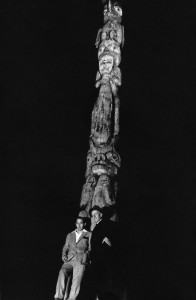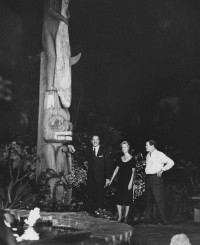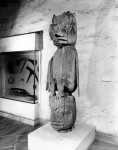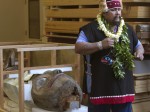 In 1931, star of stage and screen John Barrymore sailed to Alaska aboard his new 120-foot yacht the Infanta. His purpose was to hunt Kodiak bear, but he took a different kind of trophy when he visited the village of Tuxecan on Prince of Wales Island in southeastern Alaska: a totem pole 25 feet high. Barrymore had the pole sawn down leaving just a stump behind, then had it sawn into three sections to make it easier to carry on the deck of his yacht. Once home, the actor installed the totem pole on the grounds of his Beverly Hills estate, Bella Vista.
In 1931, star of stage and screen John Barrymore sailed to Alaska aboard his new 120-foot yacht the Infanta. His purpose was to hunt Kodiak bear, but he took a different kind of trophy when he visited the village of Tuxecan on Prince of Wales Island in southeastern Alaska: a totem pole 25 feet high. Barrymore had the pole sawn down leaving just a stump behind, then had it sawn into three sections to make it easier to carry on the deck of his yacht. Once home, the actor installed the totem pole on the grounds of his Beverly Hills estate, Bella Vista.
Tuxecan had been abandoned 30 years earlier when a clan leader convinced the Tlingit tribe members who lived there to move south to the town of Klawock where there was a new school and the state’s first cannery. They left behind a forest of totem poles which the villagers occasionally returned to tend to, but over time began to tip over and decay, a process that the Tlingit held to be part of the natural lifecycle of kooteeyaa (totem poles).
Tlingit totem poles were carved from single trunks of Western red cedar and raised outside people’s homes. The animals from a clan’s crest were carved on the poles, but each one had a different combination of figures and a different meaning. They celebrated family history, could commemorate a person or event or broadcast a wrong done to the pole’s owner. Some were funerary monuments that included the ashes of the dead in bentwood boxes placed in niches in the back the pole. While the were not objects of religious veneration per se, they were and are held to be sacred.
The higher the pole, the more prestigious it was. The highest poles in Tuxecan reached 30 feet or so, which means the 25-footer Barrymore stole was a very important piece in its day. Its importance has only increased with the passage of time and the loss of almost all of the more than 100 totem poles that once graced Tuxecan. Only two other original totem poles survived, moved to Klawock along with the tribe at the turn of the last century.
The totem pole makes an ominous appearance in Gene Fowler’s biography of John Barrymore, Good Night, Sweet Prince. Barrymore was warned that removing the totem pole would bring him back luck, and Barrymore, who had an interest in diverse religious traditions, was somewhat concerned that the tribal gods “might take a notion into their whimsical noggins to wreak vengeance on the thief.” If they did, they used his preexisting alcohol addiction to get to him. John Barrymore died of cirrhosis of the liver in 1942.
 The Barrymore estate was sold after his death, and the pole was bought by collector Ralph Altman. Altman sold it in the 1950s to actor, art historian and dedicated collector Vincent Price who had it installed next to his patio in his quarter-acre backyard in Benedict Canyon. Price loved it dearly, including photos of it in his books and showing it off to Edward R. Murrow in a 1958 episode of Person to Person. He described it in his memoirs as “sculptural and dignified and beautiful” with “its lovely warm browns and reds still glowing on the three great figures which compose its height. At the bottom a great bear-like creature, paws pleading; and on his head, a pale lean man who holds before him a gigantic fish which reaches from his shoulders to his toes; and on his head, hawk-nosed and savage, crouches a great bird, his tail behind him abristle with red feathers made of shingling.”
The Barrymore estate was sold after his death, and the pole was bought by collector Ralph Altman. Altman sold it in the 1950s to actor, art historian and dedicated collector Vincent Price who had it installed next to his patio in his quarter-acre backyard in Benedict Canyon. Price loved it dearly, including photos of it in his books and showing it off to Edward R. Murrow in a 1958 episode of Person to Person. He described it in his memoirs as “sculptural and dignified and beautiful” with “its lovely warm browns and reds still glowing on the three great figures which compose its height. At the bottom a great bear-like creature, paws pleading; and on his head, a pale lean man who holds before him a gigantic fish which reaches from his shoulders to his toes; and on his head, hawk-nosed and savage, crouches a great bird, his tail behind him abristle with red feathers made of shingling.”
 Price donated the totem pole to the Honolulu Museum of Art in 1981. The museum didn’t have space to exhibit the entire pole, so the top third was on display in the museum’s Kinau Courtyard while the rest was kept in climate-controlled storage. The top third joined its two brothers in storage 12 years ago when it was taken down during a renovation.
Price donated the totem pole to the Honolulu Museum of Art in 1981. The museum didn’t have space to exhibit the entire pole, so the top third was on display in the museum’s Kinau Courtyard while the rest was kept in climate-controlled storage. The top third joined its two brothers in storage 12 years ago when it was taken down during a renovation.
Meanwhile, University of Alaska Anchorage anthropology professor and Tlingit expert Steve Langdon stumbled on the totem pole in the 1990s while researching the Tlingit villages of Prince of Wales Island in a Ketchikan museum. He was looking through some old photographs when he came across a snapshot of Vincent Price standing in front of the totem pole. The cactuses indicated that this picture had not been taken in Alaska. Langdon consulted with Jonathan Rowan, a carver and cultural educator from Klawock, who helped him identify the pole in photographs of Tuxecan from the late 19th century.
 Langdon, with the blessing of Tlingit leaders, visited the Honolulu Museum of Art in 2013 with his evidence in tow. Museum director Stephan Jost recognized that Langdon had the goods. A formal investigation by the museum determined that the totem pole was indeed an object of cultural patrimony and the official repatriation process began in January of this year. On Thursday, October 22nd, the kooteeyaa was formally returned to Tlingit tribal members including Jonathan Rowan and his daughter Eva in a ceremony at the Honolulu museum. This week it sails for Alaska.
Langdon, with the blessing of Tlingit leaders, visited the Honolulu Museum of Art in 2013 with his evidence in tow. Museum director Stephan Jost recognized that Langdon had the goods. A formal investigation by the museum determined that the totem pole was indeed an object of cultural patrimony and the official repatriation process began in January of this year. On Thursday, October 22nd, the kooteeyaa was formally returned to Tlingit tribal members including Jonathan Rowan and his daughter Eva in a ceremony at the Honolulu museum. This week it sails for Alaska.
 Once home, the totem pole will be studied by Rowan and other experts in an attempt to identify which clan it originally belonged to and whether it was a mortuary monument. Altman told Price that it was, that the yacht crew members who cut it down “threw Mom and Dad in the creek” before sawing it in three. It will be difficult to determine whether it was a funerary piece because at some point during its California sojourn the back was back dug out to insert a pair of metal stabilizing rods and Barrymore had converted it into a fountain. Correcting Price’s understanding of the animals and identifying the crest is less daunting. Rowan believes from the photographs that the “bear-like creature” at the bottom may be a wolf, the “gigantic fish” is almost certainly a killer whale and the bird up top is an eagle.
Once home, the totem pole will be studied by Rowan and other experts in an attempt to identify which clan it originally belonged to and whether it was a mortuary monument. Altman told Price that it was, that the yacht crew members who cut it down “threw Mom and Dad in the creek” before sawing it in three. It will be difficult to determine whether it was a funerary piece because at some point during its California sojourn the back was back dug out to insert a pair of metal stabilizing rods and Barrymore had converted it into a fountain. Correcting Price’s understanding of the animals and identifying the crest is less daunting. Rowan believes from the photographs that the “bear-like creature” at the bottom may be a wolf, the “gigantic fish” is almost certainly a killer whale and the bird up top is an eagle.
If you’d like to learn more about the totem pole saga, Steve Langdon’s lecture at the University of Alaska Anchorage last year is on YouTube in two parts.
[youtube=https://youtu.be/NrWMzZ_8ndA&w=430]
[youtube=https://youtu.be/zVDn8plIALw&w=430]
Instead of calling Barrymore a “looter”, maybe they should somehow thank him for saving something that would now be rotted and turned to dust.
They didn’t call him a looter; that’s my phrasing. He took a historical artifact that did not belong to him, ergo, he looted it. He didn’t exactly handle it with care either, sawing it into awkward pieces and turning it into a garden water feature. Looted artifacts sometimes survive when others left in place do not, but that doesn’t make the looting a heroic act deserving of thanks and praise. Anwyay not all of the totem poles have turned to dust, so there’s no way of knowing whether this one would have survived had Barrymore not stolen it.
The Tlingit at the repatriation ceremony did thank the Honolulu Museum of Art for caring for the totem pole so well over the past few decades. Perhaps Barrymore’s ghost can piggyback off of those thanks.
“While they were not objects of religious veneration per se, they were and are held to be sacred.” I have little idea what that means; it sounds self-contradictory.
An excellent long-form article about the history of this pole, and the modern-day efforts to identify and reclaim it, was published in The New Yorker on April 20 of this year:
http://www.newyorker.com/magazine/2015/04/20/the-tallest-trophy
I’m so happy to learn that the story has come to a just resolution.
Dearieme, the term “sacred” encompasses anything imbued with religious meaning, not just objects of veneration. For example, many religions hold marriage to be a sacred bond, and some hold Jerusalem to be a sacred site, but nobody lights candles to either.
Like a rosary’s beads- they are an important part of a worship ritual, but do not embody the being one is worshipping.
When e.g. (parts of) a tombstone are removed from a ‘sacred’ graveyard, those secreted bits and pieces usually become less ‘sacred’, but not necessarily unimportant or profane to all. Secretion should not be consecrated, should it ?
Off in time and space, and therefore utterly off topic, those funerary totem pole arrangements do resemble certain graveyard sites from what is now China with poles, paddles, even canoo-shaped coffins etc. Or, remember what e.g. the ‘Moais’ from Easter Island were originally intended for. Odd as it sounds (and certainly is), if you can make from New Zealand to Hawaii within just a few centuries, reaching Alaska should not be a really big deal.
“In some instances there are striking resemblances between the articles made of perishable materials, e. g. feathers, straw and strings, from the Lop-nor graves and those from N. American Indian sites [… but also …] The analogies do not depend on any cultural connections but on similar climatic conditions.”
dsr.nii.ac.jp/toyobunko/VIII-1-B-39/V-1/images/PDF/0073.pdf
http://dsr.nii.ac.jp/toyobunko/VIII-1-B-39/V-1/page/0092.html.en
http://dsr.nii.ac.jp/toyobunko/VIII-1-B-39/V-1/page/0097.html.en
If “sacred” encompasses anything imbued with religious meaning, almost anything can be sacred, or declared to be so by an interested party. Whereas a spot of venerating can presumably be observed, or not, by someone else: in other words ‘venerated’ is, at least in principle, a testable category.
Thank you for explaining the distinction.
I can’t stop throwing up.
Same story with the once original totem pole in Pioneer Square (Seattle). Europeans taking what they wanted on drunken cruises up and down the Pacific coast. One mans lawn ornament is another’s sacred heritage is the subjective looting/preservation cycle. What’s new, humanity…
Sad but true. I imagine Barrymore thought no more about cutting down this sacred artifact than he did killing the Kodiac bears he hunted on the same trip. Just another trophy.
I didn’t know about the Pioneer Square totem. It seems it too was stolen from the Tlingit. The culprits were even indicted for theft, but the case was dismissed by a judge after the thieves, members of the Seattle Chamber of Commerce, wined and dined him. :no:
OK, my English sucks, but what do “Mom and Dad” denote in this context? I’d like to share this aticles with my students, and I must be prepared to answer all sorts of questions. Also, the totem pole looks so out of its place and time in the photos… No wonder Vincent Price, of all the actors, bought it…
“Mon and Dad” was a flippant way of referencing the remains of ancestors kept in the totem pole. It wasn’t literal because they had no way of knowing whether the ashes contained in the niches belonged to parents, grandparents or any other kind of relation. In fact, the entire story of “Mom and Dad” being dumped out could well be a fabrication as it comes down to us third hand. John Barrymore himself never documented any such event.
Thank you for the prompt answer! One of my guesses was that it could have been the _buried_ remains, but this would not be consistent with the cutting of the pole. Also, let me express my fangirlism:)
The story as Price reported it implied there were human remains in the totem pole itself which obviously Barrymore wouldn’t have wanted spread all over the deck of his yacht. We know from Tinglit tradition that funerary totem poles held the ashes of the honored dead, so if the dumping of “Mom and Dad” did happen, it would have consisted of removing the ashes from niches in the back.
Thank you for fangirling and for sharing the article with your students. 🙂